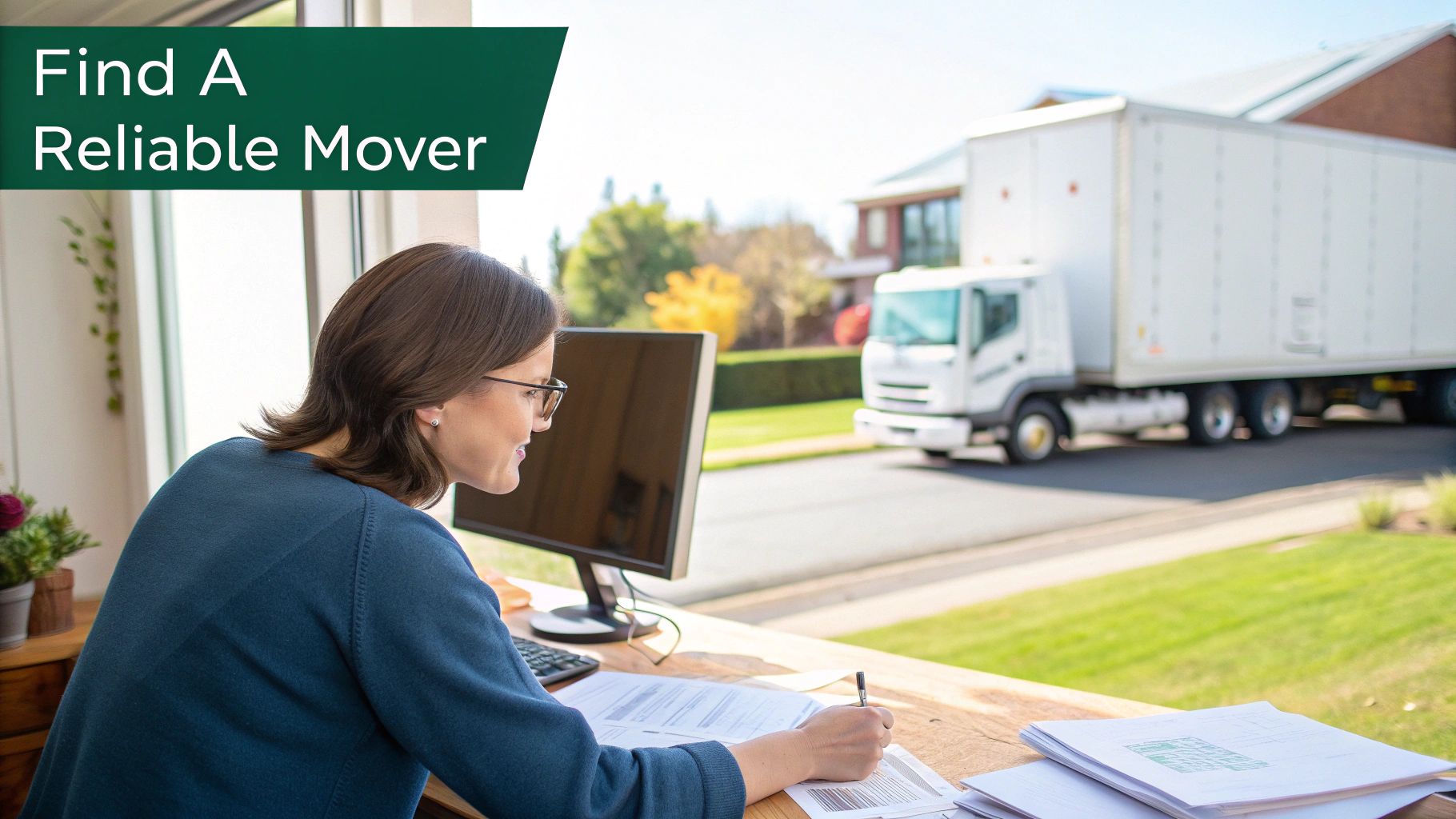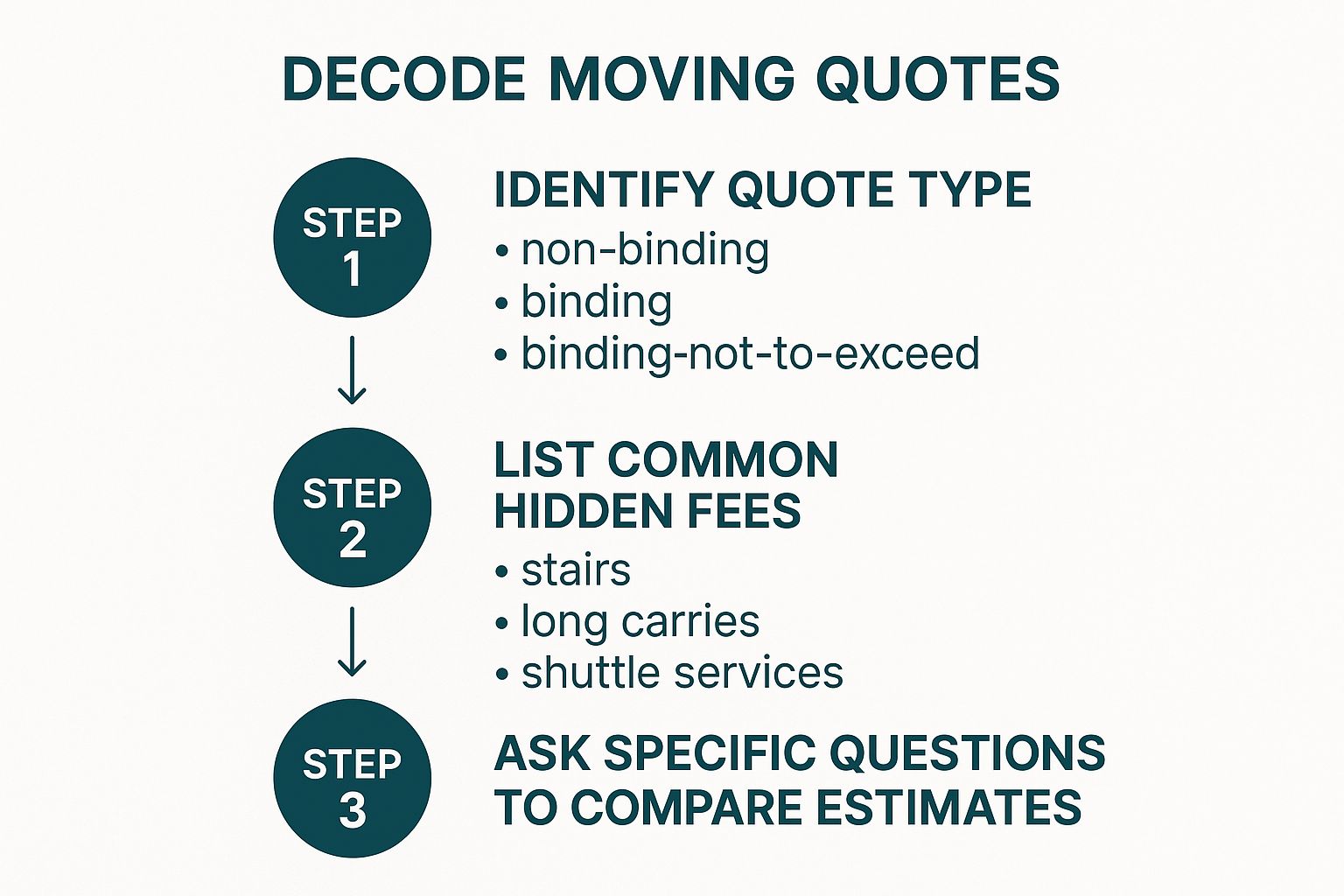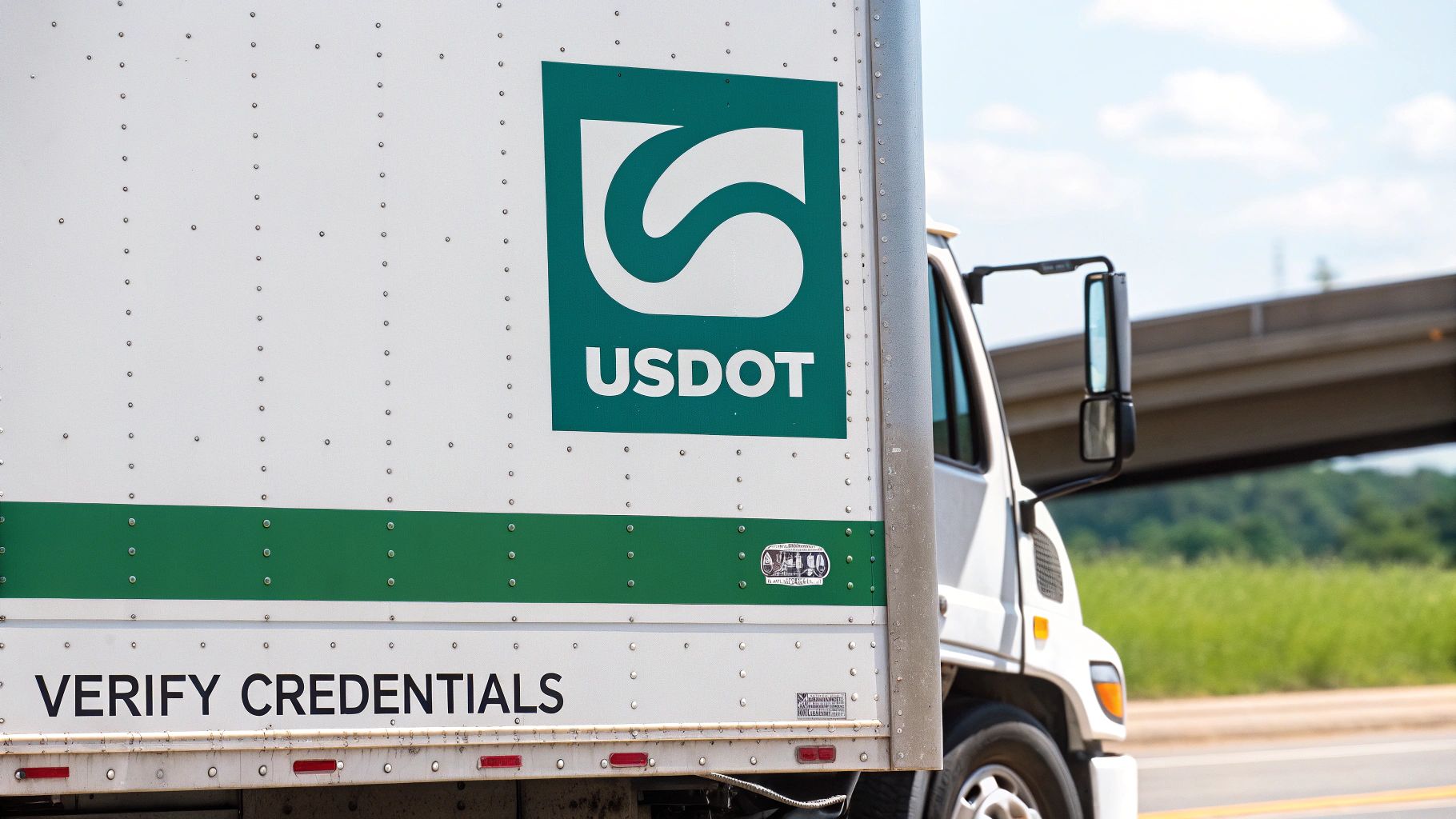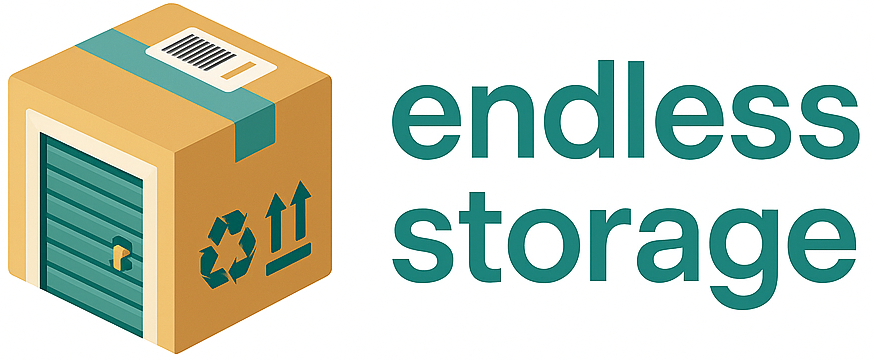Finding a great moving company really comes down to a few key actions: verifying their license and insurance, getting at least three solid quotes, and digging into real customer reviews. Following these steps is your best defense against scams and ensures you find a trustworthy partner to handle your stuff.
Your Framework for Finding a Reliable Mover

Let's be real—handing over all your worldly possessions to strangers is a massive leap of faith. That’s why figuring out how to choose a moving company isn't just about finding the lowest price. It's about building a framework for trust and accountability.
With so many options out there, a methodical approach is your best defense against stress, hidden fees, and damaged belongings.
The U.S. moving industry is a huge space, employing around 106,000 people across more than 7,600 companies. With a market size of $23.3 billion, it's clear there's a wide range of service quality you might encounter. Your job is to sift through the crowd to find a real gem.
Creating Your Vetting Process
Before you even start calling for quotes, you need a quick system to screen potential movers. This initial check saves you from wasting time on companies that don't even meet basic professional standards. Think of it as creating a shortlist of qualified candidates right from the start.
To help you get started quickly, here's a simple checklist to run through before you invest too much time in any one company.
Quick Mover Vetting Checklist
This initial scan helps you weed out the obvious duds so you can focus your energy on the serious contenders.
A reliable moving company wants to earn your trust through transparency. If a mover seems evasive, rushes you for a deposit, or avoids putting details in writing, it’s best to walk away.
Building a solid framework for selecting a moving company involves careful consideration. For more insights into picking trusted partners, you might find this guide on choosing a reliable service provider helpful.
And if your move involves downsizing or a gap between homes, exploring professional moving and storage solutions can provide some much-needed flexibility.
How to Decode Moving Quotes and Spot Hidden Fees
Getting a moving quote can feel like reading a foreign language. It's often filled with industry jargon and, if you're not careful, potential financial traps. If you want to know how to choose a good moving company, you have to get good at translating these estimates and sniffing out costs that aren't immediately obvious.
The price you see on paper isn't always the price you'll pay, especially if you don't know what to look for. Think of a surprisingly low estimate as a potential red flag. Your first line of defense against a surprise bill on moving day is understanding the different kinds of quotes out there.
The Three Types of Moving Estimates
Not all quotes are created equal—far from it. The type of estimate a company gives you determines how they calculate the final cost, so you need to know the difference before you agree to anything. Each one comes with its own set of pros and cons.
Non-Binding Estimate: This is really just an educated guess of your final moving cost, based on the estimated weight of your belongings. If your stuff weighs more than they guessed, your final bill will be higher. While you could save money if you move less than expected, it also carries the very real risk of a major price jump.
Binding Estimate: This is a locked-in, guaranteed price. The cost is fixed and won't change, even if your shipment ends up weighing more (or less) than the original estimate. This gives you peace of mind and makes budgeting a breeze, but you won't get a discount if your shipment is lighter than planned.
Binding-Not-to-Exceed Estimate: This is the gold standard—the best of both worlds. You get a guaranteed maximum price, so you know the most you'll possibly pay. But here's the kicker: if your items weigh less than the estimate, you pay the lower amount. It’s a win-win that provides a price ceiling with the potential for savings.
It's good to know that a mover can't legally demand you pay more than 110% of the original non-binding estimate upon delivery. However, they can bill you for the remaining balance, which is due within 30 days. It's not a get-out-of-jail-free card for a lowball quote.
Uncovering Common Hidden Fees
The base moving price is just one part of the equation. A lot of legitimate costs, often called "accessorial charges" in the industry, aren't included in the initial quote unless you specifically ask about them.
Being aware of these potential extras lets you have a much more honest conversation with the estimator. One of the biggest challenges for movers right now is managing expenses. Since 2020, operational costs for moving companies have shot up by as much as 80%. This impacts everything from labor to fuel, and it naturally trickles down into their pricing. For a deeper look at this trend, you can explore detailed insights on rising moving industry costs.
The infographic below gives you a simple framework for breaking down your quotes so you don't get hit with surprises.

Following a methodical process like this helps you break down each estimate and compare them apples-to-apples.
Questions to Ask About Potential Charges
The best way to get an accurate quote is to be proactive. When the estimator is doing the in-home or virtual survey, walk them through every potential hiccup and ask direct questions.
Here are some of the most common surprise fees you should always ask about:
- Stair Carry Fee: Is there an extra charge per flight of stairs? In a third-floor walk-up, this can add up fast.
- Long Carry Fee: What happens if the truck can't park right outside your door? You might get hit with a fee based on how far the movers have to walk. Ask about the maximum distance before that fee kicks in.
- Shuttle Service Fee: If a huge semi-truck can't navigate your narrow residential street, the company has to use a smaller "shuttle" truck to ferry your items. This always costs extra.
- Appliance Service Fee: Do you need them to disconnect your washer and dryer or prep your fridge? That's a specialized service and usually comes with its own fee.
- Packing Materials: Does the quote include the cost of boxes, tape, and bubble wrap, or are those billed separately? The cost of materials can be a shock if you're not expecting it.
Asking these questions upfront forces transparency and gives you a much clearer picture of your total cost. For a complete walkthrough of budgeting for your move, check out our guide on how to estimate moving costs. Your goal should always be to get an all-inclusive, written estimate to protect your budget.
Verifying Licenses, Insurance, and Credentials

This little search tool from the FMCSA is your best friend when vetting interstate movers. It's the quickest way to separate the legitimate professionals from the risky operators. Just pop in a company's USDOT number, and you can see their operating status, safety history, and insurance details in seconds.
Cracking the Code on Mover Credentials
Any moving company that operates across state lines is legally required to have a U.S. Department of Transportation (USDOT) number. Think of this as their official government ID. A reputable mover will have this number plastered on their trucks, website, and all official paperwork.
If you can't easily find it, that’s a huge red flag.
Once you have that number, head over to the Federal Motor Carrier Safety Administration (FMCSA) database to run a check. This free tool will instantly tell you if the company is properly registered and authorized to handle household moves between states.
Things are a bit different for local movers who stay within a single state. Their licensing is managed at the state level. The best way to check is to do a quick search for "[Your State] moving company license" to find the right consumer affairs or transportation agency.
Pro Tip: Never, ever hire a mover without verifying their credentials. An unlicensed company likely doesn't have the right insurance, which means if something happens to your belongings, you'll have almost no way to get compensated. It’s a gamble that just isn’t worth taking.
Demystifying Moving Insurance Options
Okay, let's talk about one of the most critical—and often misunderstood—parts of hiring a mover: the insurance. Federal law mandates that movers offer two basic types of liability coverage, and the financial difference between them is staggering.
You’ll typically see these two options:
- Released Value Protection: This is the default, no-cost option, but don't let "free" fool you. The coverage is incredibly minimal. It protects your items based purely on weight, at a rate of just $0.60 per pound per item.
- Full Value Protection: This is the comprehensive option you pay extra for. With this plan, the mover is on the hook for the full replacement value of anything that gets lost or broken. They can choose to repair it, replace it with a similar item, or offer a cash settlement for its current market value.
Let’s put that into perspective. Imagine a 10-pound antique vase valued at $1,000 gets shattered during the move.
With Released Value Protection, you’d only get $6.00 back (10 lbs x $0.60). Yes, you read that right. With Full Value Protection, you'd be covered for its actual value. It’s a night-and-day difference.
To make the choice crystal clear, here’s how these two plans stack up against each other.
Moving Insurance Options Compared
Choosing your coverage is a major decision that deserves your full attention. For an even deeper dive into what separates a professional mover from a potential nightmare, our guide on what to look for in a removal company provides some great additional insights.
Always make sure your mover clearly explains their insurance options, and get every detail in writing before you sign on the dotted line.
How to Read Customer Reviews Like a Pro
Online reviews are your best friend when vetting a moving company. A slick website is one thing, but customer feedback pulls back the curtain on what really happens when the truck pulls up and the pressure is on. This is where you get the real, unfiltered story.
But there's an art to reading reviews. Just glancing at the star rating only gives you a tiny piece of the puzzle. The real gold is in the details—spotting patterns, identifying fakes, and learning to read between the lines.
Look Beyond the Star Rating
It’s easy to get hung up on the numbers. A perfect 5.0 rating looks great, but what if it’s based on only ten vague comments? A company with a 3.8-star rating backed by hundreds of detailed, balanced reviews is often a much safer bet.
You have to look for the story behind the rating. One angry one-star review could just be a fluke or an outlier. But when you see three different reviews from last month all complaining about the same thing—say, surprise fees or broken furniture—you’ve found a red flag. That’s not a coincidence; it's a pattern.
A consistent theme, whether positive or negative, is the most reliable indicator of a company's performance. One person's bad day is an anecdote; five people telling the same story is data.
Spotting Genuine Feedback from Fakes
Not every review you read is from a real customer. Some are just too generic, and others are flat-out fabricated. Getting good at spotting the difference is crucial for making an informed choice.
Here’s what to look for in authentic reviews:
- Specific Details: Real customers mention names, places, and things. Look for comments like, "Alex and his team were fantastic," or "They handled my antique piano with extreme care." Details about the move itself, like "navigating my narrow staircase was tricky, but they did it without a scratch," are a great sign.
- Balanced Perspectives: The most believable reviews often touch on both the good and the bad. A comment like, "They were an hour late, but the crew was incredibly efficient and careful once they arrived," feels much more honest than a simple, gushing statement.
- Emotional but Reasonable Tone: You can feel real frustration or genuine relief in the writing. The best reviews don't just use extreme language; they explain why the customer felt a certain way.
On the flip side, be skeptical of reviews that are super vague ("Great service!") or use the same generic phrases over and over. These are often hallmarks of fake feedback.
Where to Find the Most Reliable Reviews
Don't put all your eggs in one basket. A mover might have a glowing reputation on one site and a trail of complaints on another. To get the full picture, you need to check a few different places.
- Better Business Bureau (BBB): The BBB is fantastic for seeing if a company has formal complaints and, more importantly, how they responded. A mover who takes the time to resolve issues is a huge positive.
- Google Reviews: This is usually the largest collection of reviews, so it's the perfect place to identify recurring themes and get a feel for their recent performance. Focus on reviews from the last six months to see how they're doing now.
- Yelp: Yelp reviewers tend to write longer, more detailed stories about their experiences. This is where you can get a deep dive into what a move with a particular company might actually feel like, for better or worse.
Even the biggest names in the business need a background check. A recent survey shows that Allied Van Lines handles nearly 13% of all moves, with American Van Lines and North American Van Lines following behind. While brand recognition suggests a level of trust, you should still discover more insights about moving company preferences and check their recent reviews to make sure they're living up to their reputation. At the end of the day, consistent, positive, and recent feedback is what truly counts.
Spotting Critical Services and Major Red Flags

Alright, you’ve checked their licenses and made sense of the quotes. Now comes the final, crucial step: making sure a mover can actually handle your specific move while keeping an eye out for warning signs.
A moving company might be perfectly legitimate but have zero experience with your type of job. On the flip side, some slick-looking operations are just scams waiting to happen. Your goal is to find that sweet spot where capability meets trustworthiness.
Matching Services to Your Move's Complexity
Not all moves are created equal. You might have more than just standard boxes and furniture. Think about it: do you own a grand piano, a fragile art collection, or an antique grandfather clock that's been in the family for generations? These specialty items aren’t just “stuff”—they need specific equipment, trained hands, and the right materials to arrive in one piece.
The team that’s a pro at simple apartment moves might be completely lost trying to hoist a baby grand out of a third-story window. It’s on you to bring up these unique challenges early on.
Here are a few service levels to consider:
- Full-Service Packing: This is the "don't lift a finger" option. The crew comes in and packs everything for you, from the silverware in your kitchen to the clothes in your closets.
- Partial Packing: Maybe you’re comfortable packing clothes and books but want the pros to handle the breakables. Many companies will expertly pack your fragile glassware, electronics, and artwork while you tackle the rest.
- Specialty Item Handling: Be direct and ask about their experience with high-value or oversized items. A true professional will confidently walk you through their exact process for crating a painting or securing a piano for transit.
If a company gets cagey or gives you a vague "Oh yeah, we can handle that" when you ask about a complex item, that’s your cue to move on. There's no room for error with your valuables. Our guide on how to protect furniture when moving offers a great baseline for what professional care should look like.
Pro Tip: A professional mover will ask you more questions than you ask them. They want to know every little detail to give you an accurate quote and prevent surprises. A shady operator, on the other hand, prefers to keep things vague.
The Most Common Moving Company Red Flags
While you’re making sure a mover has the right skills, you also need to be on high alert for scams. Con artists in this industry often prey on people’s stress and try to rush them into a bad decision. Luckily, the warning signs are usually pretty obvious once you know what to look for.
Warning Signs of a Shady Mover
Don't hesitate to walk away if you spot any of these red flags. Seriously.
- They Demand a Large Cash Deposit: Reputable movers don't need a huge chunk of cash upfront. Payment is almost always handled upon delivery. Anyone pushing hard for a big pre-move payment is a massive red flag.
- Their Greeting is Super Generic: When you call, do they answer with a professional "ABC Moving Company, this is Sarah," or a sketchy "Movers"? A generic greeting often means they're juggling multiple unregistered business names to dodge bad reviews.
- They Show Up in a Rental Truck: A legitimate, established moving company has its own fleet of branded trucks. If a plain U-Haul pulls up on moving day, it’s a clear sign you’re not dealing with a real company.
- You Can't Find a Physical Address: Check their website and business listings. If there's no legitimate, brick-and-mortar address for their office or warehouse, be extremely cautious. A company with no physical footprint is nearly impossible to hold accountable.
- They Pressure You to Decide NOW: Scammers love creating false urgency. They’ll tell you a "special rate" is only good for the next ten minutes. A professional mover will provide a detailed written estimate that’s valid for a reasonable amount of time, giving you space to decide.
Spotting these signs is your best defense against bait-and-switch scams or, in a nightmare scenario, having your belongings held hostage for more money. Always trust your gut—if a company feels off, it probably is.
Common Questions About Hiring Movers
Even after you've sorted through companies, compared estimates, and waded through reviews, a few last-minute questions always seem to surface. Choosing the right moving company is a big deal, and getting straight answers to these common concerns will help you lock in your decision with confidence.
Think of this as your final checklist. Knowing the answers here will not only get you ready for moving day but also help you feel like you're in complete control of the process.
How Far in Advance Should I Book a Moving Company?
Timing is everything. Seriously. Waiting too long to book a mover is one of the easiest ways to end up with limited (and often more expensive) options, forcing you to settle for a company that wasn't your first choice.
For a local move, try to book your moving company at least four to six weeks in advance. This gives you a comfortable cushion to do your research and snag a good spot on their calendar.
But if you're planning a move during the peak season—which is basically May through September—or on a weekend, you need to extend that timeline. Competition for good movers is fierce during these times. For any long-distance move, the stakes are even higher. Your best bet is to book two to three months ahead of your move date to ensure you get the availability and pricing you want.
Planning ahead is your single biggest advantage. Booking early doesn't just guarantee you get the company you want; it often gives you more flexibility with scheduling and better rates. Last-minute moves almost always come with a premium price tag.
What Should I Do If My Belongings Are Damaged?
It’s a gut-wrenching feeling to unwrap a box and find something broken. But if this happens, there’s a clear process to follow, and what you do in those first few moments can make a huge difference in your claim.
First things first: document everything immediately. If you can, snap clear photos of the damage from a few different angles before the movers even leave. Visual proof is your best friend here.
Next, you need to note the damage directly on the bill of lading (that's the official moving contract) before you sign off on it. This document is the legal record of your move. By adding a note about the damage, you're creating a formal record that your items didn't arrive in perfect condition.
Finally, get in touch with the moving company's customer service department as soon as you can to officially start the claims process. This is where your insurance choice—Released Value Protection vs. Full Value Protection—really comes into play. Having solid coverage makes this unfortunate situation much less stressful.
Is Tipping Movers Expected?
This question comes up all the time, and the short answer is yes. While it's not technically required, tipping is standard practice in the industry and is always appreciated for a job well done. Moving is incredibly hard, physical work, and a tip is a great way to show your gratitude for a professional and efficient crew.
So, how much is appropriate? There are a couple of common ways to go about it:
- Tip Based on Percentage: The standard is 15-20% of the total move cost. You can then have that total tip divided among the crew members. On a $1,000 move, that would work out to a $150-$200 tip for the team.
- Tip a Flat Rate: Another popular method is to tip a flat amount for each person on the crew. A good range is $20-$50 per mover, depending on how long and tough the move was. If they had to navigate five flights of stairs on a 90-degree day, you might want to lean toward the higher end.
No matter which way you go, it's usually best to give the cash to the crew foreman at the end of the day to distribute to the team. And don't forget, simple things like offering cold water and snacks can go a long way. Being fully packed and ready for their arrival is another huge help; our guide on how to prepare for movers and packers walks you through getting everything set.
Moving often comes with the challenge of managing items that don't quite fit into your new space. Whether you're downsizing or just need extra room, Endless Storage offers a hassle-free solution. We provide by-the-box storage with free pickup, climate-controlled facilities, and easy online management, so you only pay for the space you need. Visit us at https://www.endless-storage.com to simplify your storage and declutter your life.
Frequently Asked Questions
Unveiling the Secrets to Effortless Storage
Endless Storage is available nationwide. You pick a plan, tell us where to pickup, and we'll send a UPS van to collect, whichever state you're in.
Your shipping label will be sent to your email within a few minutes, if not instantaneously. It can also be accessed through your customer profile.
Your box will be shipped to one of our climate controlled self storage facilities in our closest self storage facility. Our manager will accept your package, notify you that your box has been received, and securely stored. Only our managers will have access to Endless Storage boxes.
Email us at admin@endless-storage.com click to live chat with us, or send us a message below.
Never! We're committed to transparent pricing with no surprises. You'll lock in your rate with no hidden fees and no long-term contracts.
Fast access guaranteed! Your boxes will arrive at your doorstep within 48 hours of requesting them back. Need to check on delivery? We provide tracking information for complete peace of mind.
Totally flexible! Store month-to-month with no long-term commitment and cancel anytime.
Everything's online! Use your account dashboard to:
• Set up automatic monthly payments
• Request box returns
• Update your address
• Order additional boxes
• Track shipments
Your boxes are insured up to $100 each. Our customer service team will help you file any necessary claims and resolve issues quickly.
Don't worry – we'll email you right away if there's a payment issue. Your items stay safe, though you may have temporary service interruption or late fees until payment is resolved.
When you request our free storage kits, you'll have 30 days to send in your boxes to activate your 3 months of free storage. Think of it like starting a gym membership – your activation window begins when you receive your kits, and your full free trial begins once you send in your first box. During your free months, you'll experience our complete storage service at no cost.
Your 30-day activation window begins when you receive your storage kits. We'll send you an email confirmation when your kits are delivered, marking the start of your activation period.
If you haven't sent any boxes for storage within your 30-day activation window, your free trial will expire and we'll begin charging the regular monthly rate of $9.99 per box. This helps ensure our storage kits go to customers who are ready to use our service.
A box costs $9.99 per month to store (plus sales tax). This price includes free shipping for standard boxes under 50 lbs. and smaller than 16"x16"x16"
Log into your Endless Storage account, locate the box you would like returned, and simply click Return My Box.
Yes, each box stored with us is insured for up to $100 throughout transit as well as the duration of storage within our facilities.
Your box will be at your doorstep within 48 hours of you requesting it back.
Store 10+ boxes? We'll pick them up for free! After your purchase, we'll contact you to schedule a convenient pickup time and arrange UPS collection.
We trust UPS with all shipments, and every box includes $100 insurance coverage. You'll receive tracking information to monitor your items' journey.
Yes! Visit any of our locations by appointment. Just bring a photo ID matching your customer profile.
For everyone's safety, we can't store hazardous materials, firearms, or perishables. All items must fit within our standard boxes.
It's easy! Order your storage kit online, and we'll ship it to you within 1-2 business days. Your shipping labels will be emailed instantly and available in your account.
We're here to help! Email us at admin@endless-storage.com, use our live chat, or send us a message through your account.
To cancel your storage service with Endless Storage, please email your cancellation request to admin@endless-storage.com. Our team will process your request within 2 business days and confirm your cancellation via email.
We understand packing takes time. However, to maintain your free trial benefits, you'll need to send at least one box within the 30-day activation window. If you need more time, you can always start with one box to activate your trial and send the rest later. You can always reach out to admin@endless-storage.com if you have any issues or concerns.
When you request our free storage kits, you're starting a 30-day window to begin using our storage service.
To avoid any charges, simply send at least one box for storage within 30 days to activate your 3-month free trial. If you decide not to use our service and don't send any boxes within the 30-day window, a one-time $50 fee will apply to cover the costs of materials and shipping. This helps ensure our storage kits go to customers who are ready to use our service.
Think of it like reserving a hotel room – we're setting aside space and sending specialized packing materials for your use. The fee only applies if you request materials but don't begin storage, similar to a hotel's no-show charge.

